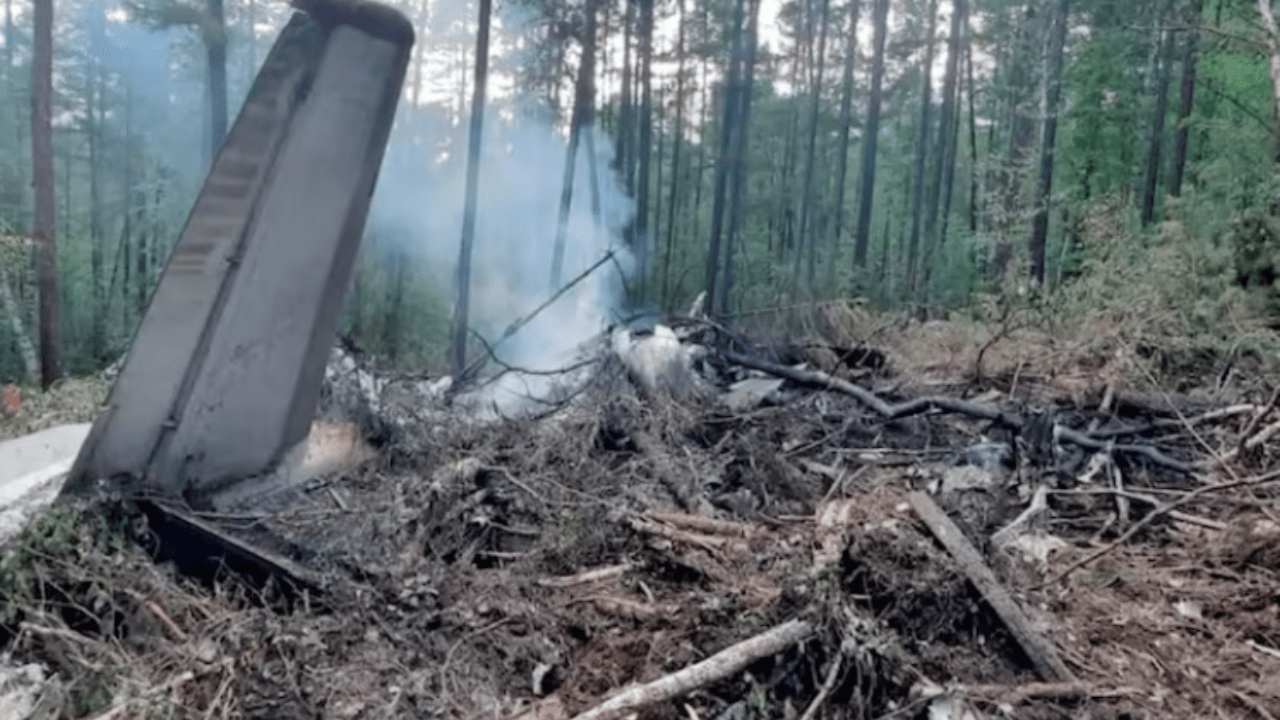A tragic Russian plane crash in the country’s far eastern region has claimed the lives of all 48 people onboard after a Soviet-era Antonov An-24 passenger plane went down while attempting a second landing. The accident occurred on Thursday as the aircraft, operated by the Siberian regional airline Angara, was approaching Tynda, a critical railway town in the Amur region.
The plane had initially failed its first landing attempt and was circling back when it disappeared from radar. Search teams later spotted the smoking wreckage of the aircraft—originally built in 1976—from a helicopter, confirming it had crashed in a remote, forested area.
Flight Details and Victims
The twin-propeller plane had departed from Blagoveshchensk, near the Chinese border, en route to Tynda. It was carrying 42 passengers, including five children, along with six crew members. Regional officials and the federal investigative body have confirmed that there were no survivors.
The Far Eastern Transport Prosecutor’s Office reported that the plane vanished during its second approach to the airport. Rescue operations were complicated by the terrain—dense forest and hilly terrain with no accessible roads—forcing teams to cut through the wilderness with heavy machinery.
Investigation and Criminal Case Launched
A criminal probe has been initiated under charges of negligent violation of air traffic and safety regulations, which resulted in the death of multiple people. While Russian news agencies reported that the aircraft had recently passed a technical inspection, it had experienced at least four minor incidents since 2018.
This disaster has again raised concerns about Russia’s continued use of outdated aircraft, especially in isolated regions where modern replacements are limited due to Western sanctions affecting access to spare parts and investment.
Global Reaction and Government Response
President Vladimir Putin offered condolences to the families of the victims and held a moment of silence at the start of a government session. Reports also confirm that a Chinese national was among the passengers, and Chinese President Xi Jinping has sent sympathies to Putin.
Moscow has formed a government commission to handle the aftermath and oversee ongoing criminal and aviation safety investigations. Angara Airlines, the carrier involved, has not released additional statements.
The Aircraft and Its Reputation: “Flying Tractors”
The plane involved was one of ten Antonov An-24s operated by Angara Airlines, all manufactured between 1972 and 1976. Angara, headquartered in Irkutsk, mainly flies routes across Siberia and the Russian Far East.
Last year, Angara and another airline formally requested the government extend the operating life of the Antonov fleet. These aircraft are nicknamed “flying tractors” due to their durability in freezing temperatures and ability to land on unpaved runways.
Although these planes are praised for their reliability in extreme conditions, experts say maintenance costs have soared following sanctions, and securing replacement parts has become increasingly difficult.
Safety History of the Antonov An-24
Originally developed in the Soviet Union, 1,340 An-24 units were produced. Of those:
- 88 have crashed
- 65 were involved in serious non-fatal incidents
- 75 remain operational today
The aircraft’s advanced age has been a subject of debate for years. In fact, former President Dmitry Medvedev proposed grounding the An-24 fleet as early as 2011, following another fatal crash that killed seven people in Siberia.
Despite plans to retire many of these planes, a modern replacement aircraft—the Ladoga—is not expected to enter mass production before 2027.
Final Thoughts
This Russian plane crash serves as a painful reminder of the aviation risks faced in remote parts of the country. As the world mourns the loss of 48 lives, questions resurface about the continued reliance on aging aircraft, especially at a time when political and economic pressures limit Russia’s ability to modernize its fleet.
The tragedy may prompt not only Russia, but also other countries operating the An-24—including North Korea, Myanmar, Ethiopia, Kazakhstan, Laos, Cuba, and Zimbabwe—to reevaluate the safety and future of these aircraft.
On July 24, 2025, an Antonov An-24 aircraft operated by Angara Airlines crashed near Tynda in Russia’s Far East while attempting to land for the second time. All 48 people onboard were killed, including six crew members and five children.
The exact cause is still under investigation. Initial reports suggest the plane disappeared from radar during its second landing attempt in poor weather. A criminal case has been opened over negligence and possible violation of air safety rules.
No, unfortunately, all 48 people onboard — 42 passengers and 6 crew members — were confirmed dead by Russian authorities.
Yes. As of 2025, countries like North Korea, Kazakhstan, Laos, Cuba, Ethiopia, Myanmar, and Zimbabwe still operate Antonov An-24 aircraft, though many are expected to retire them in the coming years.
Yes. The same aircraft was reportedly involved in four minor incidents between 2018 and 2025. Despite passing a recent technical inspection, its long-term airworthiness was questioned by experts.
Russia plans to replace the An-24 with the new Ladoga aircraft, but mass production is not expected until 2027, leaving regional airlines reliant on aging planes in the meantime.






